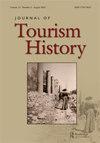走进俄罗斯自然:二十世纪的旅游、环境保护和国家公园
IF 0.9
Q4 HOSPITALITY, LEISURE, SPORT & TOURISM
引用次数: 3
摘要
艾伦·罗(Alan Roe)的《走进俄罗斯自然》(Into Russian Nature)的一些评论家,我也不例外,用“迷人”一词来描述他的专著。这是一个关于苏联自然和保护区、苏联环保主义者以及他们与官僚和意识形态风车的不切实际的斗争的真正激动人心的故事。这是一个关于苏联科学家的故事,他们与国家公园和自然保护有关的计划和梦想。这也是关于苏联绿色运动的诞生及其与西方的联系,关于苏联旅游业的现象,以及失望和破灭的希望。这本书基于广泛的主要来源:Roe使用了来自俄罗斯国家、地方和私人档案、报纸出版物、对参与者的采访以及照片和地图的数据。这本书由三部分组成,第一部分讲述了争取国家公园的历史,第二部分讲述了四个俄罗斯国家公园的故事,第三部分专门讲述了20世纪90年代初该国的情况,包括作者对整个保护区系统危机的反思。Roe以起源于俄罗斯帝国的保护区概念开始叙述。在前四章中,Roe没有列出苏联保护区每年的历史,而是简要概述了关键事件和里程碑。他说“俄罗斯国家公园的故事。。。不完全符合传统的政治年表”(第7页)适用于过去30年;然而,苏联时期的保护区历史却表明了另一种情况。苏联自然保护区(zapovedniki)的历史与该国的政治历史密切相关。20世纪30年代的工业化导致了从自然保护到积极利用的转变。20世纪30年代斯大林的清洗影响了保护区的工作人员,20世纪50年代初的谴责,以及“医生阴谋”和“明哲伦事件”,导致自然保护区的数量大幅减少。其中一些地区是在赫鲁晓夫解冻期间恢复的,当时苏联于1956年加入国际自然保护联盟,但到1961年,保护区系统已经有了新的减少,随后普遍“拧紧螺丝”。旅游业的发展与苏联和后来的俄罗斯自然保护区和国家公园之间的联系是罗专著的基石。他在整本书中追溯了苏联环保主义者中两种对立的观点。一些人主张通过他们的“破坏性仪式”(第55页)、大声的歌曲、鼓、吉他、,本文章由计算机程序翻译,如有差异,请以英文原文为准。
Into Russian nature: tourism, environmental protection, and national parks in the twentieth century
Some reviewers of Alan Roe’s Into Russian Nature, and I am no exception, use the term ‘fascinating’ to characterise his monograph. It is a truly breathtaking story about Soviet nature and protected areas, and Soviet environmentalists and their quixotic struggle with bureaucratic and ideological windmills. It is a story about Soviet scientists, their plans and dreams related to national parks and nature conservation. It is also about the birth of the green movement in the USSR and its connections with the West, and about the phenomenon of Soviet tourism, as well as about disappointments and crushed hopes. The book is based on a vast range of primary sources: Roe uses data from the Russian state, local and private archives, newspaper publications, interviews with participants and photos and maps. The book consists of three parts, the first covering the history of the struggle for national parks, the second presenting stories of four Russian national parks, and the third part being dedicated to the situation in the country in the early 1990s and including the author’s reflections on the crisis of the entire system of protected areas. Roe begins the narrative with the idea of protected areas that originated in the Russian Empire. In the first four chapters, Roe does not lay out the history of Soviet protected areas from year to year, but rather briefly outlines key events and milestones. His statement that the ‘Russian national park story ... does not fit neatly into traditional political chronologies’ (p. 7) is applicable for the last 30 years; however, the Soviet period in the history of protected areas shows otherwise. The history of Soviet nature reserves (zapovedniki) is closely connected with the political history of the country. The industrialisa-tion of the 1930s led to a shift from nature conservation to its active use. The Stalin purges of the 1930s affected the staff of protected areas and the repres-sions of the early 1950s, along with the ‘doctors’ plot’ and the ‘Mingrelian affair’, resulted in a massive reduction in the number of nature reserves. Some of these areas were restored during the Khrushchev thaw, when the USSR joined the International Union for Conservation of Nature in 1956, but by 1961 there were already new reductions in the system of protected areas and a general ‘tightening of the screws’ followed. The connection between the development of tourism and Soviet and later Russian nature reserves and national parks is the cornerstone of Roe’s monograph. He traces throughout the book two opposing ideas among Soviet environmentalists. Some advocated the protection of nature from hordes of tourists with their ‘destructive rituals’ (p. 55), loud songs, drums, guitars,
求助全文
通过发布文献求助,成功后即可免费获取论文全文。
去求助
来源期刊

Journal of Tourism History
HOSPITALITY, LEISURE, SPORT & TOURISM-
CiteScore
0.60
自引率
0.00%
发文量
16
期刊介绍:
The Journal of Tourism History is the primary venue for peer-reviewed scholarship covering all aspects of the evolution of tourism from earliest times to the postwar world. Articles address all regions of the globe and often adopt interdisciplinary approaches for exploring the past. The Journal of Tourism History is particularly (though not exclusively) interested in promoting the study of areas and subjects underrepresented in current scholarship, work for example examining the history of tourism in Asia and Africa, as well as developments that took place before the nineteenth century. In addition to peer-reviewed articles, Journal of Tourism History also features short articles about particularly useful archival collections, book reviews, review essays, and round table discussions that explore developing areas of tourism scholarship. The Editorial Board hopes that these additions will prompt further exploration of issues such as the vectors along which tourism spread, the evolution of specific types of ‘niche’ tourism, and the intersections of tourism history with the environment, medicine, politics, and more.
 求助内容:
求助内容: 应助结果提醒方式:
应助结果提醒方式:


